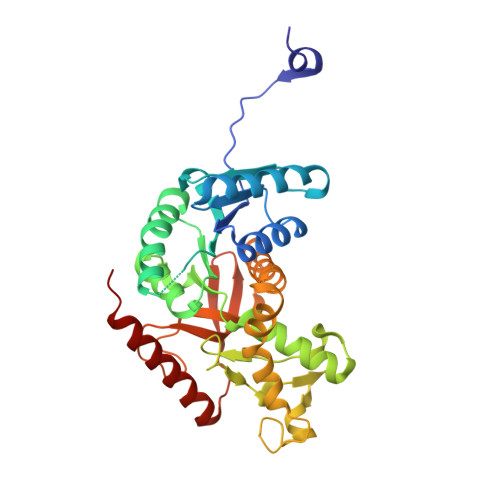Allosteric transitions of rabbit skeletal muscle lactate dehydrogenase induced by pH-dependent dissociation of the tetrameric enzyme.
Iacovino, L.G., Rossi, M., Di Stefano, G., Rossi, V., Binda, C., Brigotti, M., Tomaselli, F., Pasti, A.P., Dal Piaz, F., Cerini, S., Hochkoeppler, A.(2022) Biochimie 199: 23-35
- PubMed: 35398441
- DOI: https://doi.org/10.1016/j.biochi.2022.03.008
- Primary Citation of Related Structures:
7P4G - PubMed Abstract:
Among the functions exerted by eukaryotic lactate dehydrogenases, it is of importance the generation of lactate in muscles subjected to fatigue or to limited oxygen availability, with both these conditions triggering a decrease of cellular pH. However, the mutual dependence between lactate dehydrogenase (LDH) catalytic action and lactic acidosis is far from being fully understood. Here we show that the tetrameric LDH from rabbit skeletal muscle undergoes allosteric transitions as a function of pH, i.e. the enzyme obeys Michaelis-Menten kinetics at neutral or slightly alkaline pH values, and features sigmoidal kinetics at pH 6.5 or lower. Remarkably, we also report that a significant dissociation of tetrameric rabbit LDH occurs under acidic conditions, with pyruvate/NAD + or citrate counteracting this effect. Moreover, citrate strongly activates rabbit LDH, inducing the enzyme to feature Michaelis-Menten kinetics. Further, using primary rabbit skeletal muscle cells we tested the generation of lactate as a function of pH, and we detected a parallel decrease of cytosolic pH and secretion of lactate. Overall, our observations indicate that lactic acidosis is antagonized by LDH dissociation, the occurrence of which is regulated by citrate and by allosteric transitions of the enzyme induced by pyruvate.
Organizational Affiliation:
Department of Biology and Biotechnology, University of Pavia, Via Ferrata 1, 27100, Pavia, Italy.















